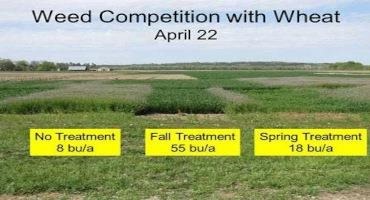Group 27 and Group 4 herbicides have little to no residual activity, thus will only control weeds that have emerged and are actively growing. This means that applying them with fertilizer in January or February when weeds are dormant will not provide good mustard control. application when weeds are dormant may not provide good control. In addition, Special care should be taken to ensure 2,4-D is not applied before wheat is fully tillered to avoid reducing tillering.
In the late winter or early spring, blue mustard is perhaps the most difficult of the winter annual broadleaf weeds to control because it bolts very early. To be effective on blue mustard, herbicides typically need to be applied in late February or early March. Blue mustard is more difficult to control than tansy mustard with 2,4-D because blue mustard has often already bolted by the time 2,4-D can be safely applied to wheat. Thus, 2,4-D often is applied too late to be effective on blue mustard.

Figure 1. Effect of timing of blue mustard control in wheat: K-State research, 2014. Photos by Dallas Peterson, K-State Research and Extension.
Flixweed and tansy mustard should be treated when they are no larger than two to three inches across and two to three inches tall. As these plants become larger, the control decreases dramatically. Ester formulations of 2,4-D and MCPA are more effective on tansy mustard and flixweed than amine formulations. Field pennycress is easier to control than tansy mustard or flixweed. Herbicide applications made before the pennycress bolts are usually effective.
Crop rotation with corn, grain sorghum, soybeans, cotton, or sunflowers is a good way of managing mustards as long as they are controlled in the spring prior to producing seed. Crop rotation will usually result in a gradual reduction of mustard populations in the future as the seedbank in the soil decreases.
Source : ksu.edu